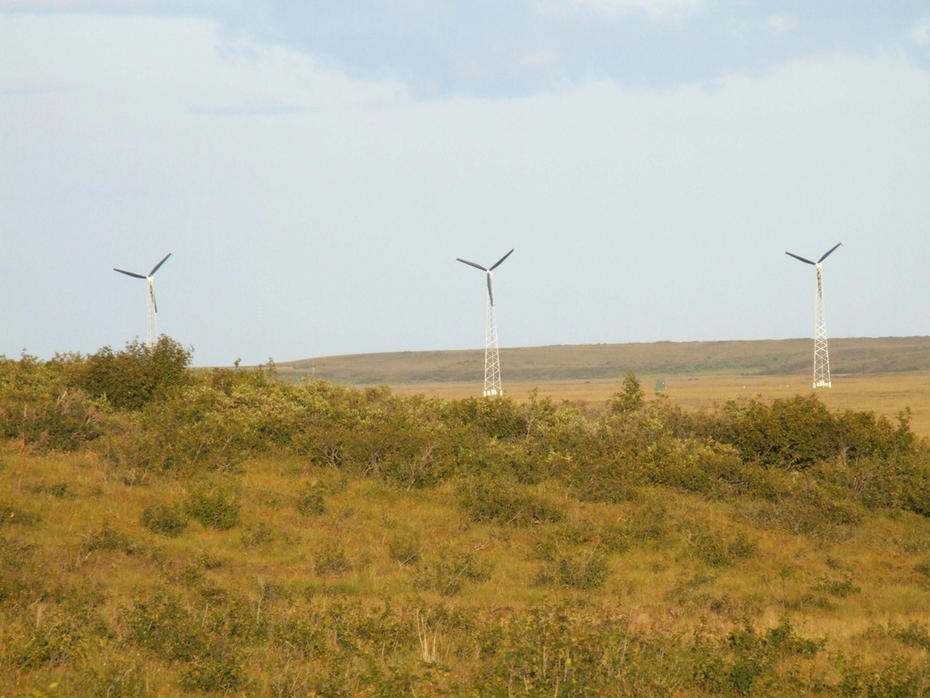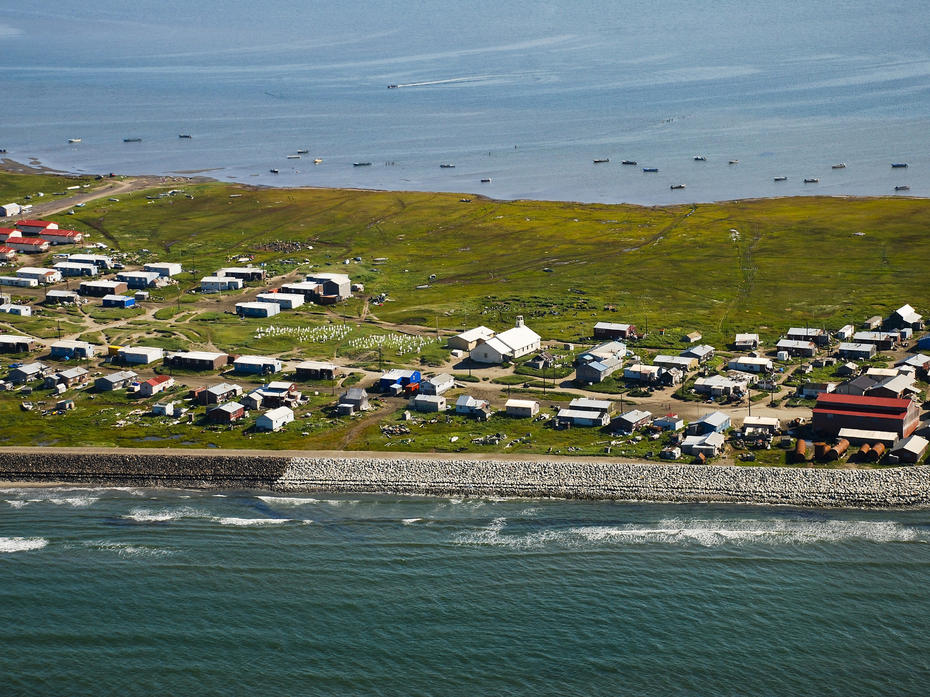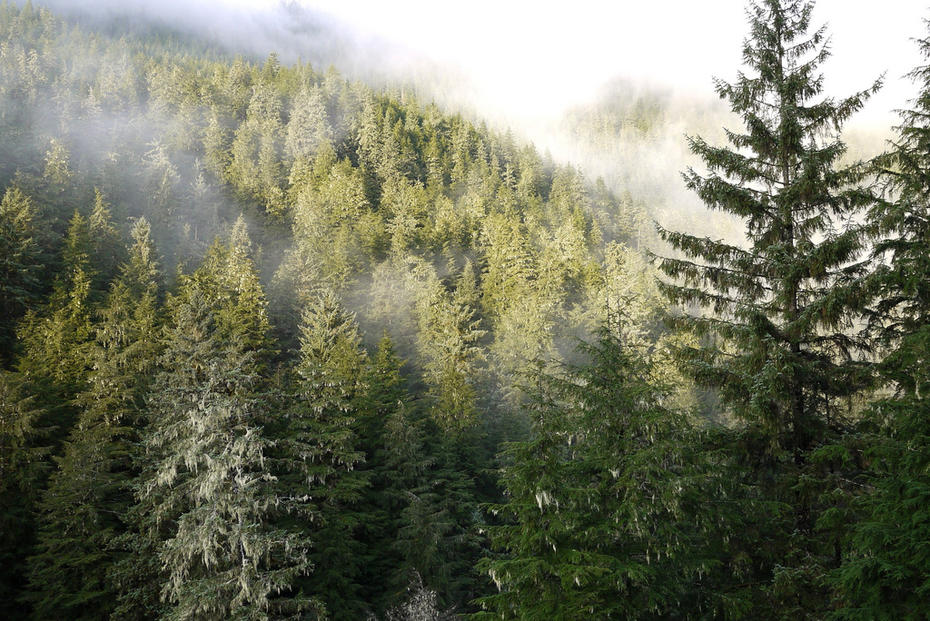Barack Obama has gone where no United States president has gone before: on an extensive tour of Alaska. He’s headed to what’s basically ground zero for climate change, where the sea ice is shrinking, the permafrost is melting, and, alas, the oil companies are drilling.
Obama is on a three-day trip to raise the profile of the rapidly changing Arctic—which is warming twice as fast as the rest of the planet—and bolster his case for the country to take climate action. In Anchorage, the president will give a speech at the GLACIER conference, a high-level international meeting on the economic and environmental issues facing the Arctic, where ecosystems, communities, and even borders seem to be unraveling. He’ll see the melting glaciers at Kenai Fjords National Park near Seward in the southeast. Then he’ll meet with people in the rural communities of Dillingham and Kotzebue, who are increasingly at risk from Arctic storms and coastal erosion on Alaska’s northwestern coast.
The visit comes on the heels of the administration’s Clean Power Plan, which aims to cut carbon pollution by 32 percent below 2005 levels over the next 25 years, and a few months before the United Nations climate talks. So far the White House has been keeping pretty quiet about what policies or actions the president might unveil while on the Last Frontier, but it’s widely expected that he’ll use the spotlight to announce steps to tackle the immense challenges facing the region.
“Addressing issues in the American Arctic has been piecemeal,” says Mike LeVine, Oceana’s Pacific senior counsel. He says a long-term, holistic plan for the region is sorely needed. We’ll have to wait to see what the administration might have in store, but here are five suggestions the president may want to consider.
CHILL, BABY, CHILL
The Obama administration recently made areas of Alaska, including a large swath of the Arctic National Wildlife refuge, off-limits to oil and gas drilling, but—and this is a big but—it also gave Shell the green light to drill in the Chukchi Sea this summer. Besides the fact that the U.S. Department of the Interior says there is a 75 percent chance of a major spill, which could devastate populations of marine mammals and seabirds as well as the state’s fishing industry, opening the Arctic Ocean to drilling is, to put it mildly, directly at odds with the president’s call to combat climate change.
“We can’t make progress on the demand side, by throttling back on coal emissions and other sources of carbon, and still afford somehow to undercut progress by opening up vast new pools of carbon to exploit and pump into the atmosphere,” says Franz Matzner, director of the Natural Resources Defense Council’s Beyond Oil Initiative. “At bare minimum, President Obama should stop Shell in its tracks and not issue any more approvals. Next, the President should put the entire Arctic off-limits to any drilling, ever.”

INVEST IN THE LONG GAME
Alaska’s economy is heavily dependent on fossil-fuel development: More than half its budget and 90 percent of the government’s discretionary spending comes from oil revenue, according to Alaska Dispatch. And an estimated 140,000 Alaskans rely on diesel to power their rural communities. “The president should be talking about getting those villages set up with renewable energy and doing it in a meaningful way—not just shipping a few solar panels and hoping for best,” says Niel Lawrence, NRDC’s Alaska project director. “We don’t have to invest in supporting Shell so that some of those jobs trickle down, producing exactly the kinds of energy that causes people’s communities to fall into ocean.”
In fact, in April, when the U.S. assumed the chairmanship of the Arctic Council (taking over the two-year position from Canada), it made the transition toward clean energy a top priority. The subject is also slated for discussion at the GLACIER conference. Already, some wind, solar, geothermal, and tidal energy projects exist, with many more under consideration.
Alaska is also serving as a testing ground for new approaches to clean energy. In the skies south of Fairbanks, for instance, Altaeros is testing a high-altitude wind turbine—a helium-filled turbine tethered to the ground that taps into winds 1,000 feet up, providing mobile energy generation.

MAKE A GETAWAY PLAN
This isn’t your great-great-great-great-great-grandfather’s Alaska. Native Alaskans are bearing the brunt of warming, which is eroding the land beneath villages, shrinking sea ice that historically buffered communities from powerful storms, and hampering fishing and hunting. While climate adaptation measures, such as constructing sea walls, are certainly critical, in some instances they won’t be enough.
Three communities have already decided re-location—from just a few miles away (as in the case of Newtok) to moving from a barrier island to the mainland (as the town of Shishmaref plans to do)—is their only option, and several other remote villages are seriously considering this. Obama has already voiced a commitment, most recently backed with $11.8 million, to help Alaska’s native communities cope with climate change.
Robin Bronen, head of the Alaska Immigration Justice Project, says such efforts are incredibly complex—and carry hefty price tags. “The laws we currently have in place are not able to meet, in my mind, the need to adapt to rapid and accelerating climatic change,” she says. For instance, disaster relief, Bronen points out, does not include erosion.
When Obama visits communities that are crumbling into the sea, perhaps he’ll announce his intentions to make existing disaster relief programs more flexible. A framework for handling climate-related displacement—something the administration has been investigating since it was highlighted as a need in a climate resilience task force report last November—would also come in handy.

MAP THE UNKNOWN
When it comes to our scientific understanding of Arctic waters and offshore environments, “there are huge information gaps,” says Oceana’s LeVine. That includes local and traditional knowledge. “We know that changes are underway, but it’s hard to understand how areas are changing—and to know exactly what we’re losing. We’re a long way from being able to map the marine food web, for instance.”
Projects like the U.S. Geological Survey’s walrus tracking study, Oceana and Audubon’s collaboration to map everything from sea-ice dynamics to bowhead whale migration, and the newly launched Arctic Marine Biodiversity Observing Network are helping to fill in some gaps. But a concerted effort to collect data on our northernmost ocean could help inform policies and the management of resources as melting sea ice gives way to shipping, fishing pressures, and (sigh) oil development.

DON’T CASH IN YOUR CARBON SAVINGS
America continues to clear-cut old-growth trees in just one national forest, our largest: the Tongass. The 17-million-acre rainforest sustains brown bears, wolves, bald eagles, and all five species of Pacific salmon. It also holds vast quantities of carbon, which, if released, would only exacerbate climate change. “The Tongass accounts for eight percent of forest carbon biomass in the United States, and U.S. taxpayers are still spending tens of millions of dollars every year to clear-cut it. It’s a national disgrace,” NRDC’s Lawrence says.
While the administration has made strides to transition out of old-growth logging in this vast rainforest, it estimates that the switch could take a decade or more. “We have got to do it faster than that.”

What happens in the Arctic doesn’t stay in the Arctic. There’s been some evidence that turning up the thermostat at the top of the world might be causing jet-stream undulations that contribute to extreme weather events in the Lower 48. “What’s happening in Alaska is what’s in store for the rest of the world,” Lawrence says, “if we don’t go all-in to fight climate change.”
If we’re going to save the world, the top of it would be a good place to start.
This post originally appeared on Earthwire as “Northward Ho!” and is re-published here under a Creative Commons license.





